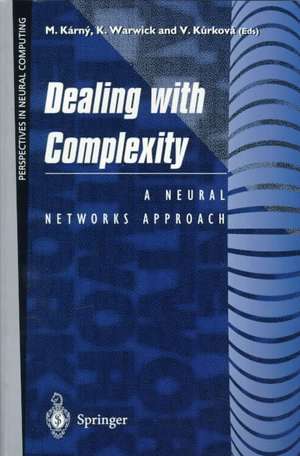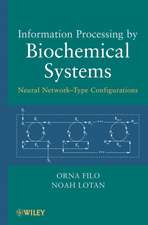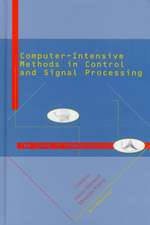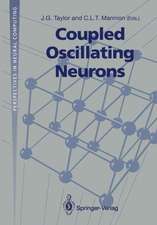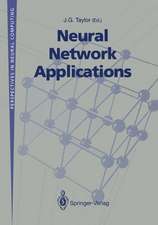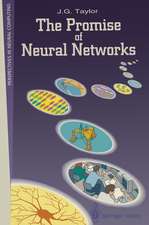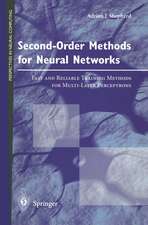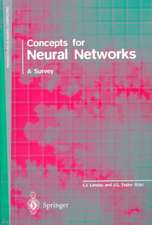Dealing with Complexity: A Neural Networks Approach: Perspectives in Neural Computing
Editat de Mirek Karny, Kevin Warwick, Vera Kurkovaen Limba Engleză Paperback – 7 noi 1997
Din seria Perspectives in Neural Computing
- 20%
 Preț: 986.66 lei
Preț: 986.66 lei - 20%
 Preț: 651.23 lei
Preț: 651.23 lei - 20%
 Preț: 1159.10 lei
Preț: 1159.10 lei - 20%
 Preț: 987.65 lei
Preț: 987.65 lei - 20%
 Preț: 583.14 lei
Preț: 583.14 lei - 20%
 Preț: 989.79 lei
Preț: 989.79 lei - 20%
 Preț: 327.29 lei
Preț: 327.29 lei - 20%
 Preț: 339.34 lei
Preț: 339.34 lei - 20%
 Preț: 639.52 lei
Preț: 639.52 lei - 20%
 Preț: 648.59 lei
Preț: 648.59 lei - 20%
 Preț: 335.52 lei
Preț: 335.52 lei - 20%
 Preț: 646.80 lei
Preț: 646.80 lei - 20%
 Preț: 647.79 lei
Preț: 647.79 lei - 20%
 Preț: 641.49 lei
Preț: 641.49 lei - 15%
 Preț: 643.99 lei
Preț: 643.99 lei - 20%
 Preț: 329.91 lei
Preț: 329.91 lei - 20%
 Preț: 326.46 lei
Preț: 326.46 lei - 20%
 Preț: 643.50 lei
Preț: 643.50 lei - 20%
 Preț: 398.07 lei
Preț: 398.07 lei - 20%
 Preț: 646.47 lei
Preț: 646.47 lei - 18%
 Preț: 786.36 lei
Preț: 786.36 lei - 20%
 Preț: 326.64 lei
Preț: 326.64 lei - 20%
 Preț: 650.73 lei
Preț: 650.73 lei - 20%
 Preț: 648.26 lei
Preț: 648.26 lei - 20%
 Preț: 652.73 lei
Preț: 652.73 lei - 20%
 Preț: 648.76 lei
Preț: 648.76 lei - 20%
 Preț: 335.18 lei
Preț: 335.18 lei - 20%
 Preț: 334.20 lei
Preț: 334.20 lei - 20%
 Preț: 335.88 lei
Preț: 335.88 lei
Preț: 648.44 lei
Preț vechi: 810.55 lei
-20% Nou
Puncte Express: 973
Preț estimativ în valută:
124.10€ • 129.08$ • 102.45£
124.10€ • 129.08$ • 102.45£
Carte tipărită la comandă
Livrare economică 15-29 aprilie
Preluare comenzi: 021 569.72.76
Specificații
ISBN-13: 9783540761600
ISBN-10: 3540761608
Pagini: 328
Ilustrații: XV, 308 p. 5 illus.
Dimensiuni: 155 x 235 x 17 mm
Greutate: 0.5 kg
Ediția:1st Edition.
Editura: SPRINGER LONDON
Colecția Springer
Seria Perspectives in Neural Computing
Locul publicării:London, United Kingdom
ISBN-10: 3540761608
Pagini: 328
Ilustrații: XV, 308 p. 5 illus.
Dimensiuni: 155 x 235 x 17 mm
Greutate: 0.5 kg
Ediția:1st Edition.
Editura: SPRINGER LONDON
Colecția Springer
Seria Perspectives in Neural Computing
Locul publicării:London, United Kingdom
Public țintă
ResearchCuprins
1 Recurrent Neural Networks: Some Systems-Theoretic Aspects.- 1 Introduction.- 2 System-Theory Results: Statements.- 3 System-Theory Results: Discussion.- 4 Computational Power.- 5 Some Remarks.- 2 The Use of State Space Control Theory for Analysing Feedforward Neural Networks.- 1 Introduction.- 2 State Space Theory.- 3 State Space Representation of Feedforward Neural Networks.- 4 Observability of Feedforward Neural Networks.- 5 Controllability.- 6 Stability.- 7 Discussion.- 8 Appendix: Linear Systems of Equations [7].- 3 Statistical Decision Making and Neural Networks.- 1 Introduction.- 2 Statistical Decision Making.- 3 Bayesian Learning.- 4 On Ingredients of Bayesian Learning.- 5 Interlude on Gaussian Linear Regression Model.- 6 Approximate On-Line Estimation.- 7 Conclusions.- 4 A Tutorial on the EM Algorithm and its Applications to Neural Network Learning.- 1 Introduction.- 2 The EM Algorithm.- 3 Practical Applications.- 4 Convergence Properties.- 5 Concluding Remarks.- 5 On the Effectiveness of Memory-Based Methods inMachine Learning.- 1 Introduction.- 2 Background.- 3 The Curse of Dimensionality.- 4 The Barron-Jones Theory.- 5 Experimental Results.- 6 Analysis of Memory-Based Methods.- 7 Discussion.- 6 A Study of Non Mean Square Error Criteria for the Training of Neural Networks.- 1 Introduction.- 2 Statement of the Problem.- 3 Cost Function Minimisation for ? = E(y/x).- 4 Cost Function Minimisation for the Median of p(y/x).- 5 Simulation Results.- 6 Conclusion.- 7 A Priori Information in Network Design.- 1 Introduction.- 2 Preliminaries.- 3 Recurrent Networks and Relative Order.- 4 Simulations.- 5 Conclusions.- 8 Neurofuzzy Systems Modelling: A Transparent Approach.- 1 Empirical Data Modelling.- 2 Neurofuzzy Construction Algorithms.- 3 Modelling Case Studies.- 4Conclusions.- 9 Feature Selection and Classification by a Modified Model with Latent Structure.- 1 Introduction.- 2 Modified Model with Latent Structure.- 3 Optimizing Model Parameters.- 4 Approach to Feature Selection.- 5 Pseudo-Bayes Decision Rule.- 6 Experiments.- 7 Summary and Conclusion.- 10 Geometric Algebra Based Neural Networks.- 1 Introduction.- 2 Complex-Valued Neural Networks.- 3 Comments on the Applicability of CVNNs to n-Dimensional Signals.- 4 Generalisations of CVNNs Within a GA Framework.- 5 Summary.- 11 Discrete Event Complex Systems: Scheduling with Neural Networks.- 1 Introduction.- 2 The DNN Architecture.- 3 Continuous Time Control Law.- 4 Real-Time Scheduling.- 5 Simulation Results.- 6 Summary.- 12 Incremental Approximation by Neural Networks.- 1 Introduction.- 2 Approximation of Functions by One-Hidden-Layer Networks.- 3 Rates of Approximation of Incremental Approximants.- 4 Variation with Respect to a Set of Functions.- 5 Incremental Approximation by Perceptron and RBF Networks.- 6 Discussion.- 13 Approximation of Smooth Functions by Neural Networks.- 1 Introduction.- 2 Preliminaries.- 3 Complexity Theorems.- 4 Local Approximation.- 5 Some Open Problems.- 14 Rates of Approximation in a Feedforward Network Depend on the Type of Computational Unit.- 1 Introduction.- 2 Feedforward Networks with Various Computational Units.- 3 Discussion.- 15 Recent Results and Mathematical Methods for Functional Approximation by Neural Networks.- 1 Introduction.- 2 Individual vs Variable Context.- 3 Nonlinear Approximation.- 4 Feedforward Architectures.- 5 Lower Bounds on Rate of Approximation.- 6 Uniqueness of Approximation by Neural Networks.- 7 Other Approaches.- 16 Differential Neurocontrol of Multidimensional Systems.- 1 Introduction.- 2 Neurophysiological Basis.- 3 Scheme of the Differential Neurocontroller.- 4 Multiplicative Units.- 5 Feedback Block.- 6 Feedforward Block.- 7 Convergence of Learning.- 8 Computer Simulations.- 9 Conclusions.- 17 The Psychological Limits of Neural Computation.- 1 Neural Networks and Turing Machines.- 2 Function Approximation.- 3 Representation of Logical Functions Using Neural Networks.- 4 The Complexity of Learning in Neural Networks.- 5 Learning Logical Functions.- 6 The Optimization of Circuits.- 7 Final Remarks.- 18 A Brain-Like Design to Learn Optimal Decision Strategies in Complex Environments.- 1 Introduction.- 2 Time-Chunked Approximate Dynamic Programming.- 3 Temporal Chunking with Neural Networks.- 4 Spatial Chunking and Critical Subsystems.- 5 Adding the Third Brain.- Research Acknowledgements.
